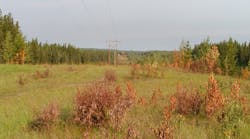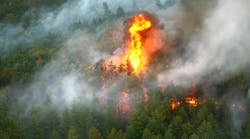In last month’s article I mentioned that at TransAlta, we used a two-stage audit process for herbicide applications. The first stage simply verified that the intended treatment area was in fact treated. This is easy to detect because treated brush will show signs of herbicide toxicity, essentially brown leaves. However, brown leaves do not indicate an effective herbicide application. An effective herbicide application is one that eliminates the possibility of new bud formation and break. This means the herbicide must lead to the death of the cambium layer or meristematic tissue. Until this is evident, you cannot be assured that the herbicide has produced the sought-after results. In some cases the cambium may be dead in the fall of the treatment year but in other cases it may take considerably more time -- up to 14 months. It depends on the herbicide and the tree species treated.
Hey newbie, let me give you hand
If you relatively new to this business, you will now be wondering how do I assess stem kill? You approach a treated stem with your pocket knife in hand and start near the top of the tree scraping off bark so that the cambium layer is exposed. If the cambium is healthy it will be white or green and the bark will slip easily. If it is dead it will be orange or brown and the bark will not slip. Now you are going to mentally divide the tree into tenths. If you found that the cambium is healthy and yet the terminal buds are clearly dried out and dead, you would rate the stem kill as 5%. However, let’s assume that the first cut revealed dead cambium. You would then work your way down the stem peeling bark about every tenth of the height. In this way you can determine what percent of the stem has been killed. If the cambium is dead all the way to the ground line that is 100% stem kill. In this way you’ll find it quite easy to rate stem kill in 5% increments. As you gain experience you will see differences in bark color that will indicate how far down the tree the cambium has died. The instead of checking in 10% increments you can check just above the bark discoloration to confirm dead cambium and work down from there.
One is not enough
Don’t be satisfied with one stem. Whether you are evaluating the herbicide(s) for efficacy or evaluating the contractor’s application, you want statistically valid results. I suggest ten stems per species per site. You will need at least 30 stems of each species evaluated. Keeping in mind that you want to avoid bias, decide in advance the sampling process. Don’t make it difficult. The process is arbitrary but once decided must be rigorously followed. Here’s one that I use. I will take the next closest tree of the species I’m working on, moving in a northerly or easterly direction. Once you have at least 30 stems by species evaluated you can determine the sample size needed achieve a 95% confidence level. Without having any data that number is 384. The more consistent the stem kill, that is lower the variability, the fewer samples required to achieve the desired confidence level. Consequently, it is quite conceivable that the calculated number of samples required will fall somewhere between 100 and 200.
The data needs to be segregated by treatment, that is, by herbicide or herbicide mixture and by tree species. Do not mix data for different treatments.
The data you will need to record is: location information, the herbicide solution and concentration, the date treated, the date evaluated and the percent stem kill for each sample stem. The back at the office all you have to do is determine the average stem kill by herbicide/herbicide mix and tree species. Over a couple of years you will attain considerable insight to what amount of control you can expect for each herbicide and herbicide mix you use. That’s it unless you have tree species that have a penchant for vegetative reproduction.
Too simple? Here’s the curve ball
If during your evaluations of the herbicide program you are finding root suckers, then the measure of control becomes more complex. You will then need to frame your choice of herbicide as the one that while meeting all environmental constraints provides the greatest maintenance free period for the dollar invested. I won’t go into the evaluation of root sucker regrowth but will point you to The Validity of an Estimation of Biomass found in the Related Articles section.


